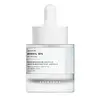What's inside
What's inside
 Key Ingredients
Key Ingredients

No key ingredients
 Benefits
Benefits

 Concerns
Concerns

No concerns
 Ingredients Side-by-side
Ingredients Side-by-side

Water
Skin ConditioningPropanediol
SolventBetaine
HumectantSodium PCA
HumectantPanthenol
Skin ConditioningSodium Lactate
BufferingArginine
MaskingPCA
HumectantAspartic Acid
MaskingGlycine
BufferingAlanine
MaskingSerine
MaskingThreonine
Valine
MaskingProline
Skin ConditioningIsoleucine
Skin ConditioningLysine Hcl
Skin ConditioningHistidine
HumectantPhenylalanine
MaskingGlutamic Acid
HumectantCitric Acid
BufferingDimethyl Isosorbide
SolventPolysorbate 20
EmulsifyingTrisodium Ethylenediamine Disuccinate
1,2-Hexanediol
Skin ConditioningCaprylyl Glycol
EmollientWater, Propanediol, Betaine, Sodium PCA, Panthenol, Sodium Lactate, Arginine, PCA, Aspartic Acid, Glycine, Alanine, Serine, Threonine, Valine, Proline, Isoleucine, Lysine Hcl, Histidine, Phenylalanine, Glutamic Acid, Citric Acid, Dimethyl Isosorbide, Polysorbate 20, Trisodium Ethylenediamine Disuccinate, 1,2-Hexanediol, Caprylyl Glycol
Water
Skin ConditioningButylene Glycol
HumectantHydrogenated Polyisobutene
EmollientGlycerin
Humectant1,2-Hexanediol
Skin ConditioningGlyceryl Stearate Se
EmulsifyingCetearyl Alcohol
EmollientSorbitan Stearate
EmulsifyingCarbomer
Emulsion StabilisingCetearyl Olivate
Sorbitan Olivate
EmulsifyingTromethamine
BufferingSodium Lactate
BufferingInulin Lauryl Carbamate
Emulsion StabilisingPolysorbate 20
EmulsifyingHydrolyzed Sponge
Skin ConditioningAdenosine
Skin ConditioningDisodium EDTA
Hydrolyzed Hyaluronic Acid
HumectantAnemarrhena Asphodeloides Root Extract
Skin ConditioningPalmitoyl Tripeptide-1
Skin ConditioningPalmitoyl Tetrapeptide-7
Skin ConditioningPanthenol
Skin ConditioningMadecassoside
AntioxidantCentella Asiatica Extract
CleansingWater, Butylene Glycol, Hydrogenated Polyisobutene, Glycerin, 1,2-Hexanediol, Glyceryl Stearate Se, Cetearyl Alcohol, Sorbitan Stearate, Carbomer, Cetearyl Olivate, Sorbitan Olivate, Tromethamine, Sodium Lactate, Inulin Lauryl Carbamate, Polysorbate 20, Hydrolyzed Sponge, Adenosine, Disodium EDTA, Hydrolyzed Hyaluronic Acid, Anemarrhena Asphodeloides Root Extract, Palmitoyl Tripeptide-1, Palmitoyl Tetrapeptide-7, Panthenol, Madecassoside, Centella Asiatica Extract
 Reviews
Reviews

Ingredients Explained
These ingredients are found in both products.
Ingredients higher up in an ingredient list are typically present in a larger amount.
1,2-Hexanediol is a synthetic liquid and another multi-functional powerhouse.
It is a:
- Humectant, drawing moisture into the skin
- Emollient, helping to soften skin
- Solvent, dispersing and stabilizing formulas
- Preservative booster, enhancing the antimicrobial activity of other preservatives
Panthenol is a common ingredient that helps hydrate and soothe the skin. It is found naturally in our skin and hair.
There are two forms of panthenol: D and L.
D-panthenol is also known as dexpanthenol. Most cosmetics use dexpanthenol or a mixture of D and L-panthenol.
Panthenol is famous due to its ability to go deeper into the skin's layers. Using this ingredient has numerous pros (and no cons):
Like hyaluronic acid, panthenol is a humectant. Humectants are able to bind and hold large amounts of water to keep skin hydrated.
This ingredient works well for wound healing. It works by increasing tissue in the wound and helps close open wounds.
Once oxidized, panthenol converts to pantothenic acid. Panthothenic acid is found in all living cells.
This ingredient is also referred to as pro-vitamin B5.
Learn more about PanthenolPolysorbate 20 is made by combining ethoxylation of sorbitan, ethylene oxide, and lauric acid. It is a mild cleansing agent, surfactant, and emulsifier.
As a surfactant, it helps collect dirt and oils for washing. Emulsifiers prevent oils and water from separating.
Polysorbate 20 also adds scent to a product. Since it is made using sorbitol, it has a sweet scent. Sorbitol can also be found in fruits such as apples and peaches.
The lauric acid used to create Polysorbate 20 is often derived from coconuts.
Polysorbate 20 may not be fungal acne safe.
Learn more about Polysorbate 20Sodium Lactate is the sodium salt of lactic acid, an AHA. It is a humectant and sometimes used to adjust the pH of a product.
This ingredient is part of our skin's NMF, or natural moisturizing factor. Our NMF is essential for the hydration of our top skin layers and plasticity of skin. NMF also influences our skin's natural acid mantle and pH, which protects our skin from harmful bacteria.
High percentages of Sodium Lactate can have an exfoliating effect.
Fun fact: Sodium Lactate is produced from fermented sugar.
Learn more about Sodium LactateWater. It's the most common cosmetic ingredient of all. You'll usually see it at the top of ingredient lists, meaning that it makes up the largest part of the product.
So why is it so popular? Water most often acts as a solvent - this means that it helps dissolve other ingredients into the formulation.
You'll also recognize water as that liquid we all need to stay alive. If you see this, drink a glass of water. Stay hydrated!
Learn more about Water